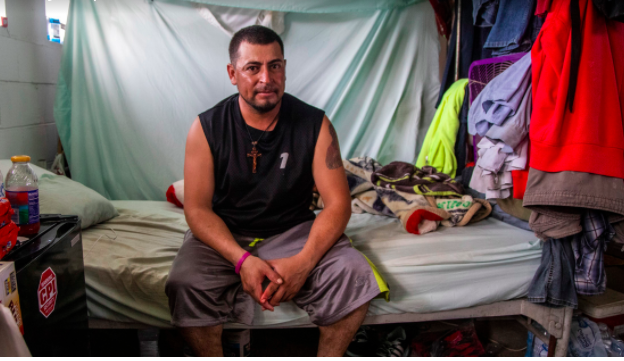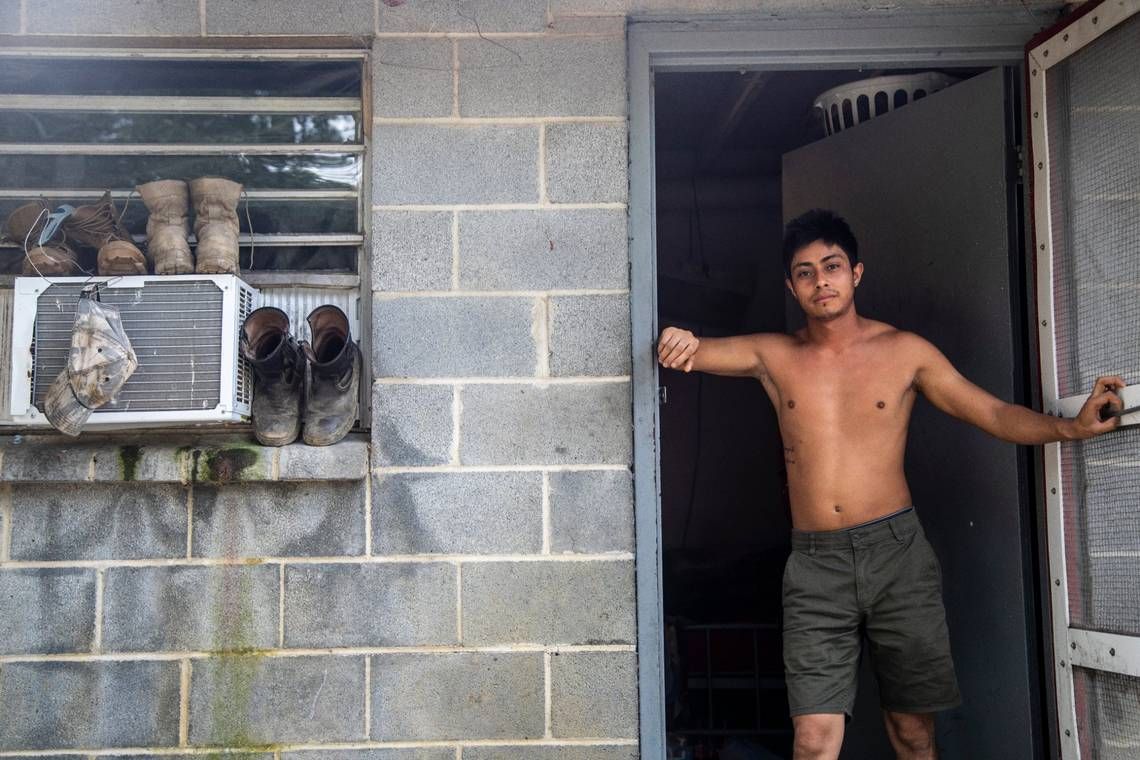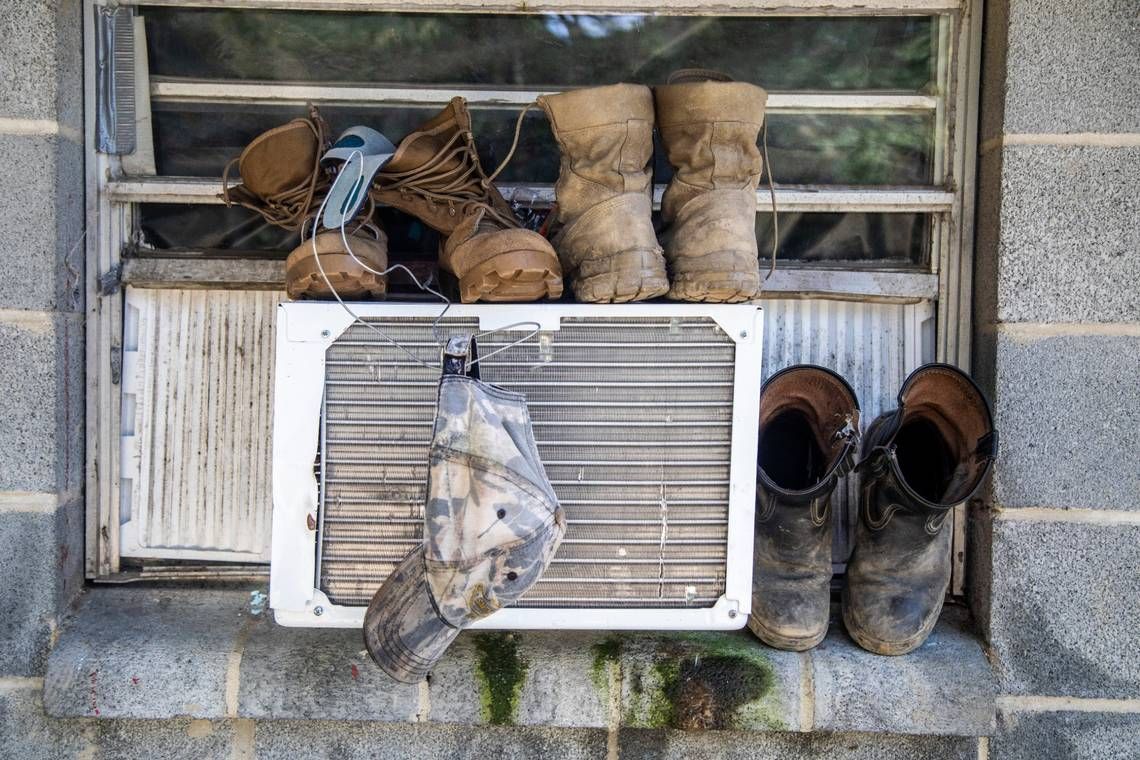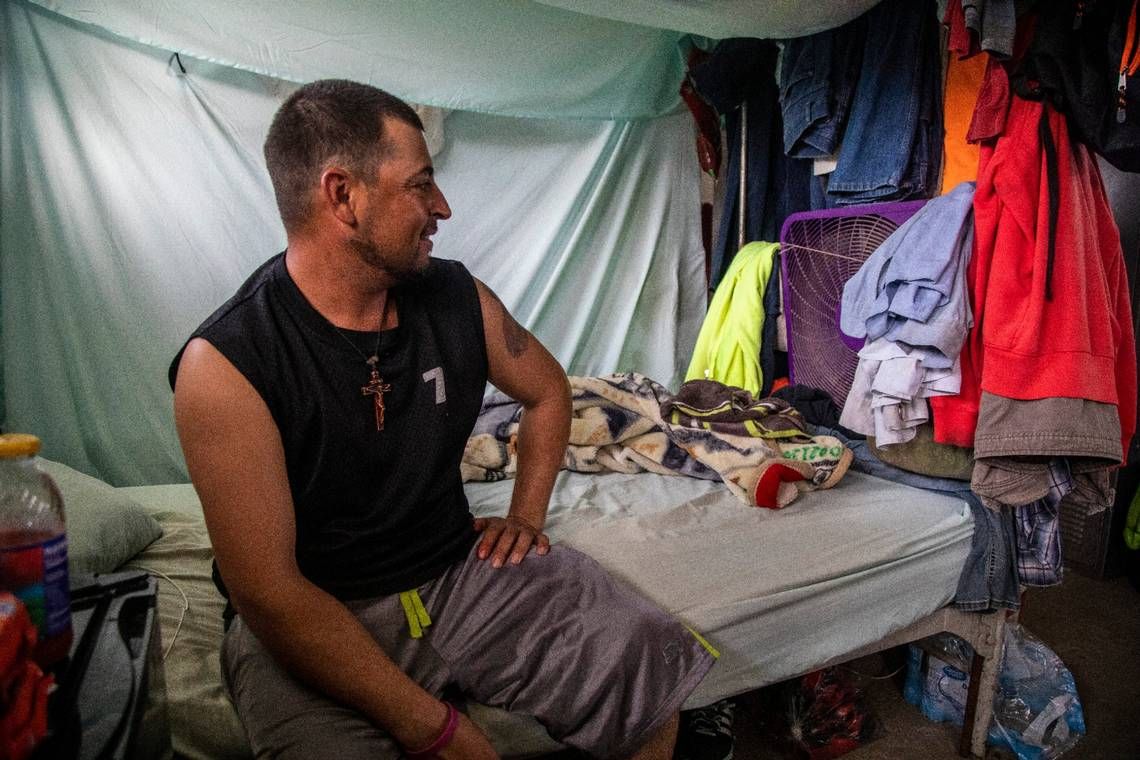In North and South Carolina, sea-level rise is most noticeable in counties along the coast, where beaches shrink, dunes disappear and homes crumble, but the effects of climate change reach well inland. “Beyond the Beach” is a seven-part series examining the health toll that climate change is already taking on the people who live and work in the Carolinas.
The project is a partnership of The News & Observer in Raleigh, North Carolina, The State in Columbia, South Carolina, Columbia Journalism School and the Center for Public Integrity. Funding support for “Beyond the Beach” came from the Pulitzer Center on Crisis Reporting. Columbia Journalism Investigations, an investigative reporting unit at the Columbia Journalism School, also contributed to the project. Funding for CJI comes from the school’s Investigative Reporting Resource and the Energy Foundation.
This summer, Rafael traded the beans and maize of his native Veracruz, Mexico, for Johnston County’s tobacco and soy.
Rafael was working in those fields at about 11 a.m. in late July when he suddenly felt dizzy. He couldn’t breathe. He vomited.
“I felt like I couldn’t keep working and I got cramps,” Rafael told The News & Observer in Spanish about a month later.
Rafael stood shirtless as he spoke to the N&O one day after work. Nearby, wet clothing hung on a line. Workers were scattered around the one-story barracks, many sitting under trees, some with cool towels draped over their heads while they scrolled their smartphones.
About 150,000 farmworkers harvest North Carolina’s crops, tend to its fields and support the state’s largest industry.
This is an industry that comes with particular risks. Outdoor work is a leading cause of reported heat illness in North Carolina, according to the N.C. Department of Health and Human Services. A 2016 Wake Forest University study found that 36% of 101 farmworkers surveyed have suffered symptoms of heat illness while working outside, while 67% have worked in temperatures they called “extremely hot.”
“We always know that heat is a threat,” said Gayle Thomas, the medical director of DHHS’ farmworker health program.
These conditions are almost certain to get worse, a direct consequence of human-caused climate change leading to more hot days, more heat waves and warmer nights. By the middle of the century, it is likely that annual average temperatures will rise between 2 and 5 degrees Fahrenheit, according to the N.C. Climate Science Report released earlier this year.
Farmworker advocates point to heat standards, or rules requiring growers to give workers more breaks and provide water when temperatures are high, as one possible solution. California and Washington have passed such laws, but there are political hurdles in North Carolina.
One thing is certain: Workers in the fields are already noticing a different climate.
David has come to North Carolina every summer since 2002. Like all of the farmworkers in this story, David agreed to talk with the N&O if he was identified by only his first name in order to protect his job.
While some years are warmer than others, David said in Spanish, the temperature used to start growing cool in September.
“Not anymore,” David said in late August. “Now it’s hotter, and the cool climate doesn’t come until October.”
More Warms Days Ahead
Michelle Tigchelaar was a researcher at the University of Washington in 2017 when a farmworker died picking blueberries in the coastal community of Bellingham.
“That really sparked my interest from an academic point of view — realizing people in my research community weren’t thinking at all about the people doing the work and focusing on the crops,” Tigchelaar, now an early-career fellow at the Stanford Center for Ocean Solutions, said in an interview with the N&O.
Tigchelaar wanted to find out when working conditions grow unsafe for farmworkers and what steps they can take to make the summer months safer. Her research looked at workers’ pace, the kind of clothing they wear and how frequently they take breaks.
Under existing working conditions, farmworkers become susceptible to heat illness when the heat index averages 83.4 degrees Fahrenheit, Tigchelaar reported in a study published in August in the journal Environmental Research Letters.
That number was initially surprising, Tigchelaar said, because it is much lower than what either the National Weather Service or OSHA identify as a dangerous range.
“It reflects the actual work people are doing and how they are doing that work, specifically as it regards clothing, where the Weather Service and OSHA reflect the general population,” Tigchelaar said, noting that farmworkers often wear multiple layers of clothing to protect themselves from pesticides.
If global warming is held to two degrees Celsius, or 3.6 degrees Fahrenheit, the number of unsafe working days will double. If the world warms four degrees Celsius, or 7.2 degrees Fahrenheit, Tigchelaar projects that the number of unsafe working days will triple.
Graphic by David Raynor. Source: Research by Michelle Tigchelaar, fellow at the Stanford Center for Ocean Solutions.
Here’s what that looks like in practice: In Duplin County, where there are 823 agricultural workers, there are 41 days where the heat makes working conditions unsafe right now. Under the two degree Celsius scenario, there would be 91 unsafe heat days. At four degrees, there would be 121 unsafe days, or roughly four months.
In South Carolina, 25 counties are projected to have more than 100 unsafe days under the two-degree scenario, led by Beaufort County with 118. Brunswick would be the only North Carolina county likely to reach that threshold, although other counties in the southeastern part of the state would be close.
The four degree Celsius scenario would see virtually every county in North and South Carolina hit 100 unsafe working days, with the exception of a dozen counties in the western North Carolina mountains.
“At that point, you’re looking at basically the entire growing season is unsafe if we continue working the way we’re working,” Tigchelaar said.
In her paper, Tigchelaar calls for “the full spectrum of risk-reduction levers” to protect farmworkers from intensifying temperatures.
The research found, for instance, that the dangerous heat index rose to 95.2 degrees Fahrenheit — giving them a greater margin of safety — if workers worked 54 minutes of every hour at a light pace wearing single-layer clothing and resting in air-conditioned spaces. Under a different scenario, where workers spent every half-hour working at a light pace wearing double-layer clothing and resting in shade, the heat stress threshold would creep upward to 97.3 degrees.
Without changes, Tigchelaar warned, farmworker productivity could decline as the temperatures rise.
“There will probably be a lag between that productivity and increases in temperature because people aren’t always in a position to prioritize their health in that regard,” she said, “but ultimately as people are struggling in the heat, that will impact people’s ability to do the work.”
Farmers Can’t Take NC Heat
Javier came to Johnston County in 2018.
That first summer was the hottest, said Javier, who has learned to go into the fields with a straw hat on and a bandanna around his head or neck. Despite the high temperatures, he wears a long-sleeved shirt to keep the chemicals that collect on wet tobacco leaves from touching his skin.
That’s not always enough, though.
“There are times that the body can’t take the heat the same daily. There are times that the body can’t handle the temperature, and sometimes the weather is OK but your body can’t handle the work,” Javier told the N&O in Spanish.
Days grow the hottest around 1 p.m., Javier said. As he spoke, Javier was sitting on his bed in his grower-provided housing, one of four arranged around the edges of the small room. Each bed seemed to belong to one person’s space. A box fan hung diagonally from the ceiling, pointed at the head of one of the beds.
A window cooling unit was turned to 60 degrees, but the temperature inside was nowhere near that cool. Underneath Javier’s bed sat a collection of soft drinks, sports drinks and electrolyte packets.
Several times this summer, Javier has felt nausea and insomnia set in, illnesses he attributes partly to green tobacco sickness caused by nicotine from wet leaves and partly to heat illness. When he or other workers feel sick, Javier said, they head to the school bus that takes them to and from work. Often, that is the only spot of shade.
When that happens, Javier said, workers’ pay is cut for the time they spend recovering on the bus.
Would a Heat Standard Help NC Farmers?
North Carolina farmworker advocates, DHHS and the state Department of Labor each provide training around heat illness. Outreach workers conduct health assessments and educate farmworkers about the symptoms of heat illness, while the Department of Labor has created a PowerPoint presentation for employers.
But North Carolina does not have any explicit rules requiring farmers to take specific steps to protect their workers from high temperatures.
The N.C. Department of Labor confirmed that through Dolores Quesenberry, a department spokeswoman. Instead, Quesenberry wrote, the Occupational Health and Safety Division can write citations for violations of the General Duty Clause, a wide and vague standard that says employers need to protect employees from recognized hazards causing serious harm.
While the state labor department’s agricultural health division has conducted 66 inspections leading to general duty clause violations since 2010, Quesenberry said it was impossible to tell how many of those were for heat exposure.
But legal advocates question how effective the general duty clause really is at providing protections against heat.
Lori Johnson, the managing attorney of Legal Aid of North Carolina’s farmworker unit, said there is a distinct difference between a law requiring breaks at certain intervals in certain conditions and the general duty clause, which only protects workers’ rights to take a break if not doing so would put them at risk of imminent harm.
“The end result is that people take fewer breaks, even if they probably need it,” Johnson said.
Advocates and researchers have long called for a national heat standard, a labor rule requiring growers to provide certain breaks or cooling guidelines if temperatures reach certain levels. But these efforts have gained little traction outside of California, Minnesota and Washington, which have adopted such rules.
Another important protection provided by a heat standard is that by codifying paid breaks, it protects workers who are often unwilling to take breaks because of how they are paid.
“Often, they’re paid by the piece, meaning they’re paid by how much they harvest instead of by the harvest,” said Thomas, the DHHS medical director. “And they are here for one purpose and that’s to make money during the agriculture season to send to their families.”
“Farmworkers are already an exploited vulnerable population, so they’re afraid to ask for more breaks and they’re afraid to ask for medical attention,” said Joanna Wellborn, a spokeswoman for Student Action With Farmworkers, which recruits students to work with partner agencies who aid farmworkers.
Wellborn also said there hasn’t been a concerted push for state heat standards because they would have little chance of succeeding due to the strong influence of the agriculture industry in Raleigh. Instead, she said, the organization is pushing for federal heat standards.
“We think we would have a better chance,” Wellborn said.
Current efforts at federal legislation include the Asuncion Valdiva Heat Illness and Fatality Prevention Act of 2019, a House bill whose 79 Democratic co-sponsors include North Carolina’s Alma Adams. The bill would require the federal Department of Labor to enact a heat standard within 18 months of its passage, require employers to create heat illness prevention plans and mandate employer-provided training.
But efforts against a heat standard have prominent opponents. During a visit to the North Carolina State Farmer’s Market in September, Sonny Perdue, the U.S. secretary of agriculture and a self-described “old farm boy,” said he thinks workers can take care of themselves.
“I’m probably the wrong person to ask about those kind of standards because I’ve lived them,” Perdue said. “I’ve experienced them side by side with many people working on a farm. Farm work is hard work, it’s hot work. That’s why we have difficulty finding domestic workers who tell you they want to work on farms.
“So I understand the challenges, but as far as standards, we want people to take care of themselves. If I felt sick or faint or hot, go sit under a shade tree, drink some water and go back to work.”
North Carolina farmworkers and advocates think a heat standard would help, though.
Javier, who has suffered heat illness in Johnston County, said that while his boss sometimes calls workers out of fields early if temperatures are especially high, a heat standard “would be good.”
And Thomas Arcury, who along with his wife, Sara Quandt, has studied heat illness among North Carolina’s farmworkers for more than two decades, minces no words.
“We need a heat standard,” Arcury, the director of Wake Forest University’s Center for Worker Health, said in an interview. “That would be a big help now, and that would be a big help later, as temperatures rise.”
Arcury’s Wake Forest team conducted a study that found more than a third of the farmworkers they interviewed had suffered heat illness.
To differentiate between heat illness and poisoning from nicotine gathered on tobacco leaves, the Wake Forest team asks workers about their symptoms, said Arcury. While the maladies can overlap, Arcury said, a headache or dizziness combined with vomiting are typically green tobacco poisoning, while muscle cramps and clamminess are signs of heat illness.
The conditions can also exacerbate each other, though.
“One of the major problems with heat illness is dehydration,” Arcury said. “If you’re vomiting all of your fluids out and you can’t take down fluids because of green tobacco sickness, that exacerbates the effects of heat.
California’s Heat Standard
To see how a heat standard would actually work, North Carolina could look to California.
Following a series of heat-related farmworker deaths in 2005, California regulators enacted emergency heat regulations. A year later, the California Division of Occupational Safety and Health’s first heat standard went into effect.
The most recent version of the rule requires employers to: create and maintain a written plan for dealing with high temperatures; provide heat illness prevention training for employees and staff; encourage workers to drink at least 32 ounces of water each hour; and provide shade.
As part of the effort to provide shade, employers tow roofed-in trailers with benches built on top of the work sites. Others have shades built onto the sides of buses that extend out to protect against the sun.
Furthermore, there are additional rules that go into effect when the temperature reaches 95 degrees. At that point, employers must either observe employees for ill effects from heat or implement a buddy system. Furthermore, workers must be allowed to take a 10-minute break every two hours, with additional breaks every two hours after the traditional eight-hour workday.
As the director of the California Rural Legal Assistance Foundation’s pesticide and work safety project, Anne Katten has long recognized the risks heat poses to farmworkers. Along with the United Farm Workers Union, Katten worked on the initial rule in 2005 and has been part of several efforts to update it.
The regulation has, Katten said, “improved conditions. There’s more water and shade out in the field, and workers are getting trained more. There is a pretty good curriculum out there — shade, water, rest — but there’s always room for improvement.
“Unfortunately,” Katten continued, “the frequency of heat waves is increasing, so the pressure on workers is increasing.”
Katten also recognizes that there are potential weaknesses to any rule. For instance, she points to the rule’s saying that shade and water need only to be as close as is practical. Advocates have, Katten said, called for there to be limits to how far away resources can be placed from a work site.
Another potential shortfall is the California regulation’s basis solely on degrees Fahrenheit. That is not, Katten said, as much of a problem in California where much of agricultural work takes place in dry heat, but in the Southeast humidity can exacerbate the impact of heat on the body and it may be more appropriate to base a regulation on the heat index or another measurement.
“There has been improvement,” Katten said, “but we need more improvement, and as much as possible, we need to just try to reduce the amount of time workers have to work in the heat.”
‘It’s Complicated’
When he fell ill in July, Rafael, the Johnston County farmworker, took nausea and pain medicine. He also drank water mixed with an electrolyte packet to restore fluids to his body.
As the summer wore on, Rafael acclimated. He also learned how to protect himself.
When he goes to work now, Rafael wears a hat. He’s also added layers of clothing to protect himself against the chemicals gathered on tobacco plants.
But even though he earns more in one hour in North Carolina than in a day back home, Rafael is not sure he’ll return next year.
“It’s complicated,” he said, “but I want to finish the season and see if I like it.”
This story is part of the Pulitzer Center’s nationwide Connected Coastlines reporting initiative. For more information, go to pulitzercenter.org/connected-coastlines.
This reporting was also financially supported by Report for America/GroundTruth Project, The North Carolina Local News Lab Fund of the North Carolina Community Foundation, Dogwood Health Trust, Solutions Journalism Network and more than 700 individual contributions. The News & Observer maintains full editorial control of the work. To support the future of this reporting, subscribe or donate.




